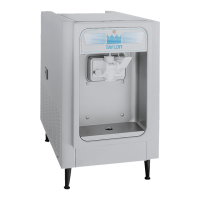17
Models 150, 152, 162, 168
Controls and Systems
The L1 power supplied to the compressor contactor
coil passes through the watt control relay (socket
connection #2 and #3).
The L1 power supplied to the beater motor must first
pass through the watt control (socket connection #5
and #6).
When the viscosity setting is attained, the watt control
relay is activated (#2 and #3 open) to discontinue
sending power to the compressor contactor coil. The
refrigeration system cycles off and the watt control
relay relaxes (#2 and #3 closed).
Once the refrigeration system has cycled off, the solid
state timer is activated. When the off-cycle time has
elapsed, the solid state timer sends L1 power through
the watt control (socket connection #2 and #3) to the
coil of the compressor contactor. The compressor
contactor initiates compressor operation and also
supplies L1 power to the beater motor. The solid state
timer re-sets to zero each time the compressor
contactor closes.
Setting the Viscosity Control
(Also see Control Range Selection.)
Step 1
Locate the L1 power path passing through the watt
control to the beater motor (socket connection #5 and
#6). Install an amp meter on the L1 power path to
monitor the amperage of the beater motor.
(Old Style Only)
Step 2
T urn the viscosity adjustment potentiometer clockwise
to the coldest setting.
Step 3
With the freezer properly primed, activate the
refrigeration syst em.
Step 4
During the freezing process, draw samples and
inspect the product appearance. When the desired
product viscosity is achieved, note the beater motor
amperage.
Step 5
Slowly turn the viscosity adjustment pot
counterclockwise (warmer) to cycle off the
refrigeration syst em.
Step 6
Draw several samples to verify the amperage at
cycle-off time and the product appearance remains
consistent.
Control Range Setting
The watt control is used in many different freezer
models which have a variety of electrical
specifications. For this reason, the watt control must
be set to operate in an amperage range which relates
to the beater motor amperage and the desired product
viscosity setting.
Note: Although the watt control monitors beater
motor wattage, the beater motor amperage is used as
a reference to set the control and check the operation.
The selected amperage range simply determines the
adjustment span of the viscosity adjustment
potentiometer on the face of the control.
There are four range selections to choose from as
shown on the range selection chart.
Range Selection Chart (Old Style Only)
1.2 -- 2.4 None
2.3 -- 4.6 White
4.0 -- 8.0 White and Blue
5.7 -- 11.4 White, Blue and Yellow
Note: The range selection is not thesame as the TQC
range selection.
(Old Style Only)
On the front of the watt control there are three colored
jumper wires (white, blue, and yellow). The proper
range selection is determined by running the freezer to
determine the beater motor amperage when product
reaches the desired viscosity and cutting the jumper
wire(s) indicated on the range selection chart.
With no jumper wires cut, use the following procedure
to determine the proper range selection.
Step 1
Locate the L1 power path passing through the control
to the beater motor (socket connection #5 and #6).
Install an ampmeter on the L1 power path to monitor
the amperage of the beater motor.
Step 2
T urn the viscosity adjustment potentiometer clockwise
to the coldest setting.

